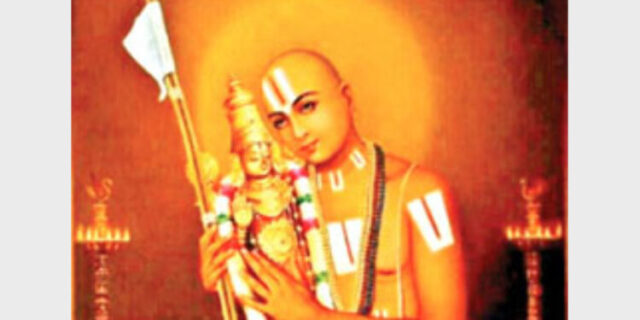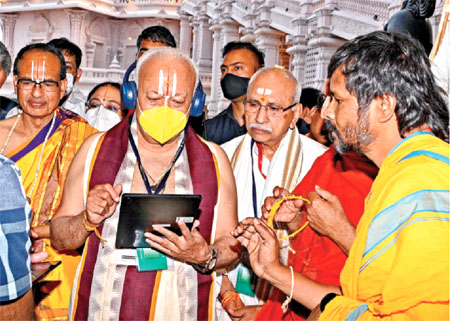
Knower of the self with his divine eyes looks equally at the inner-self lying within Brahmin, cow, elephant, dog and an outcaste – says the Bhagavat Gita
One who emulates this important message of the Gita and worked upon it, throughout the life, we know him as Shri Ramanujacharya, and in the divine memory of whom the country is celebrating ‘Shri Ramanuja Sahasrabdi Samaroham- February 12-14’ (1,000th birth celebration year). Though remembered more for the great work he did in the realm of spirituality, in the field of social- equality initiatives he took were no less notable.
Beyond Barriers
Shri Ramanuja was born to a Brahmin family, but he used to consume food with his devotee from Kanchi, who hailed from so-called low caste. Going far ahead, he made it mandatory to sing in the temple devotional-songs created by low-caste Tamil saints. He had the gates of the famous Tirunarayan Perumaal Vaishnav temple opened to give entrance to all irrespective of one’s caste . It was because of divine influence of Ramanuja that Gollas, a backward community of South India, were granted the right of first darshan of Shri Balaji.
‘National Interest above All’
“Remember, priority should be ‘Hindu interest’, that is, national interest. Other interests, such as language, caste are secondary. We will not engage in anything that instigates to fight within. We will live with dignity. Our capability is such that nobody has the power to stand against us. They tried a lot to destroy us, but to no avail. If we had to be finished, it would have happened in the last 1000 years. It’s them who have. Our 5000-year-old Sanatan Dharma is intact” |
Ramanuja earned the knowledge of different schools of Dharma from five different acharyas. But living in the proximity of whom he learnt Ramayana was Sri Nambi (Ghosthipoorna), who was born to low-caste parents. Initially, when he went to him to seek his mastership, Nambi asked, “Hailing from low-descent, how could I teach a Brahmin like you.” At this, Ramanuj answer was, ‘Does one get to be Brahmin merely by putting yagyopavit (sacred thread)? One who has devotion to God, he only is true Brahmin. Great Aalvar saints belonged to different castes other than Brahmin, but they all were Bhagavad Bhaktas. By virtue of his abilities, low–born Thiruppan Aalvars were worshipped by many Brahmins. Despite being a Kshatriya, Yudhisthira used to worship low-born Vidur.
Another principal spiritual master of Ramanuja was Shri Periar Nambi (Mahapoorna). He too belonged to low-caste, and from whom Ramanuja earned knowledge of Vedas and Nalayir Prabandham (Tamil Veda). It was this Guru who initiated him into Vaishnava-faith, and from here only he later rose as a successor to the supreme seat of Vaishnavism. In Vaishnava cult, Tiruvaimouli is considered to be the basic scripture of bhakti and philosophy, the writer of which was Nammalvar, who belonged to untouchable caste. Ramanuja inspired one of his disciples to write a treatise on Tiruvaimouli.
He had the habit of taking bath in the river. In the old age, when physical weakness prevented him from walking on his own, he used to take the support of Brahmin, Dashrathi, while reaching the river; and, also of so-called low-caste, Dhanurdas, while returning from there. One day, when one of his disciples asked about it, his answer was, “Bathing purifies my physical body, but not mind. The complex of being superior to the others is all what is called ego, which is a greatest obstacle in the path of the progress of the man. After cleaning the dirt of my physical body by bathing, I purge the mind of ego by coming into contact with the low-castes. I am not superior to anybody, nor anybody is inferior to me. This feeling makes me one with divine bliss.”
A Bridge between North and South
Relinquishing every other desire and feeling spiritually fulfilled in one divine refuge of God, the saints who got to be imbued with this sentiment of devotion were popularly known in South India as Aalvar. The saint by whom this cult of devotion later came into prominence as ‘Prapatti’ was Ramanuja. He opened the door to ‘Prapatti’ for all those who had been so far deprived of availing the refuge and divine bliss of Dharma due to obscurantism.
Later, during the 14th century, inspired by ‘Prapatti’, Ramanand Swami did unprecedented work of giving social-base to the ‘Bhakti movement’ that he launched in Northern India. Bhakti Movement thus emerged as a bridge between North and South India, credit of which of course goes to Shri Ramanuja.
Courtesy : ORGANISER
This article was first published in 2022















